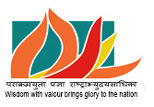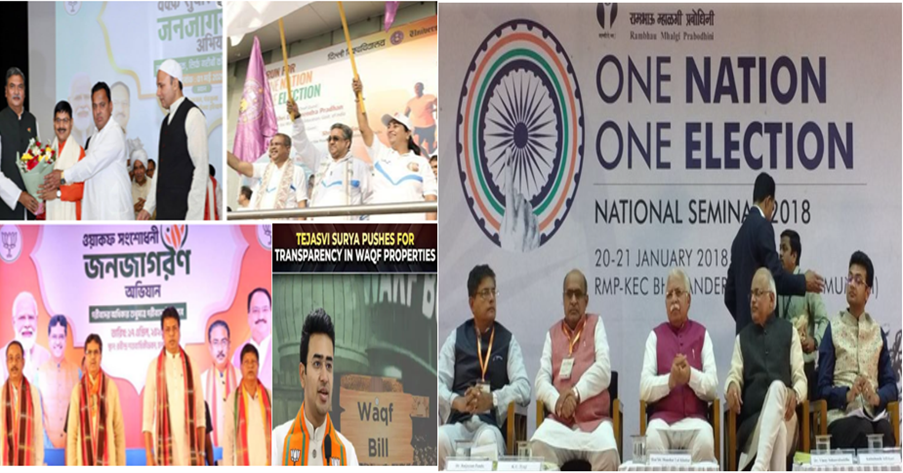A Nation in Transition
India, a land of deep-rooted democracy and pluralistic traditions, is undergoing two pivotal transformations: the push for One Nation, One Election and the institutional restructuring of the Waqf Board system. Both represent more than policy measures—they symbolize a paradigmatic shift toward administrative efficiency, equitable governance, and constitutional integrity. These reforms confront entrenched systems—fragmented electoral cycles and opaque land trusts—challenging historical inefficiencies while reaffirming the foundational ideals of unity, secularism, and development.
PART I : One Nation, One Election – Reviving the Spirit of Unified Democracy
- The Historical Backbone of Simultaneity
India began its democratic journey with synchronized elections. From 1952 to 1967, Lok Sabha and state assemblies were elected together. But frequent dissolutions of state governments fractured this rhythm, burdening governance with an unending cycle of elections.
The proposal for One Nation, One Election is not novel—it is restorative. As echoed in Organiser Weekly’s editorial series, it aims to correct systemic drift by reinstating a unified electoral schedule.
- Disruptions and Costs of Electoral OverloadWith the Model Code of Conduct invoked for every election, policy paralysis becomes routine. Governance halts. Funds, police, and bureaucracy are diverted. The 2019 general elections alone cost over ₹60,000 crore.
Frequent elections also encourage opportunistic populism, identity politics, and coalition brinkmanship—challenges a synchronized system would neutralize.
- Legal and Logistical Recalibration
Implementing this reform requires constitutional amendments (Articles 83(2), 172), changes in the Representation of the People Act (1951), and administrative upgrades—especially in EVM and VVPAT infrastructure.
Organiser’s analysis suggests a phased implementation—beginning with aligning elections in states whose terms conclude near the general elections, ultimately leading to a consolidated democratic calendar.
- Democratic Maturity and Federal Safeguards
Critics claim it threatens regional issues and autonomy. But voter behaviour disproves this—India’s electorate has shown the capacity for split-ticket voting.
Rather than imposing central control, synchronised elections would empower state governments to complete full terms, free from mid-cycle political turbulence.
PART II: Waqf Board Reforms – From Secrecy to Transparency
- The Parallel Governance Structure
Waqf properties, estimated at over 8 lakh acres, make the Waqf Boards the third largest landholder in India. Intended as perpetual endowments for religious and charitable purposes, these properties have become hubs of unaccounted wealth, legal ambiguity, and political patronage.The Waqf (Amendment) Bill, 2025 is a long-awaited intervention. It introduces inclusivity, transparency, digital traceability, and judicial accountability—shifting the narrative from sacred untouchability to civic responsibility.
- Key Reforms Introduced
a. End of ‘Waqf by User’
This colonial-era clause allowed land used religiously for 30+ years to be declared Waqf—even without ownership proof. The 2025 amendment repeals it, stopping unauthorized takeovers of public and private land.
b. Plural Representation
- Mandatory inclusion of non-Muslim members.
- Muslim women and members from all sects must be represented—ending clerical monopolies.
c. Appeals and Legal Recourse
Waqf tribunals are no longer final. Aggrieved parties can now appeal in High Courts, restoring judicial balance.
d. Digital Land Registration
A national portal will document every Waqf property’s status, ownership, use, and legal disputes—closing loopholes that allowed secret transfers and encroachments.- A Network of Encroachments and Injustice
Organiser’s investigations revealed that Waqf Boards leased or transferred properties to politically connected individuals at throwaway rates. Parks, schools, temples, and crematoriums have been claimed under “Waqf by user.”The amendment seeks to break this opaque chain and establish Waqf institutions as accountable public entities, not extrajudicial fiefdoms.
- Opposition and Clarification
Opponents allege that the amendment is anti-Muslim or unconstitutional. But every religious body in India—Hindu trusts, Church organizations, Sikh Gurdwaras—is regulated. Exempting Waqf alone is a violation of equality. The amendment doesn’t dissolve Waqf—it strengthens it. With fair auditing, broad representation, and legal redress, it ensures that properties serve actual charitable purposes, not individual gain.
- Land Ownership: Waqf Boards vs. Indian Railways
- Waqf Boards: As per recent data, over 25 Waqf Boards in India oversee approximately 850,000 properties, encompassing around 900,000 acres of land. This vast expanse positions Waqf Boards among the top landowners in the country.
- Indian Railways: In contrast, Indian Railways owns about 43,000 hectares (approximately 106,000 acres) of vacant land. This land is strategically utilized for operational purposes and commercial development through the Rail Land Development Authority (RLDA).
- Employment Generation: Waqf Boards vs. Indian Railways
- Waqf Boards: Despite the extensive landholdings, Waqf Boards have not significantly contributed to employment generation. The management of these properties often lacks transparency and efficiency, leading to underutilization of potential job opportunities.
- Indian Railways: Indian Railways stands as one of the largest employers globally, with a workforce exceeding 1.25 million individuals. This includes various departments such as engineering, operations, and administration, contributing substantially to employment across the nation.
- Revenue Contribution: Waqf Boards vs. Indian Railways
- Waqf Boards: The revenue generated by Waqf properties remains minimal, primarily due to mismanagement and lack of commercialization. Instances like the Karnataka Waqf Board Land Scam highlight the challenges, where approximately 27,000 acres were misappropriated, causing significant financial losses.
- Indian Railways: In the fiscal year 2022-23, Indian Railways achieved a record revenue of ₹2.4 lakh crore. This includes ₹1.62 lakh crore from freight and ₹63,300 crore from passenger services, reflecting a robust and efficient revenue model.
Leadership and Public Mobilization: The Vanguard Leaders
Prime Minister Narendra Modi: Visionary Catalyst
PM Modi has been the most vocal advocate for ONOE. He sees it as a foundational reform for a Viksit Bharat by 2047. His leadership has not only revived the debate but transformed it into a national movement. Modi ji has linked ONOE to transparency, cost-saving, and democratic efficiency in multiple speeches and party meetings.
Amit Shah: Architect of Political Strategy
Home Minister Amit Shah has worked behind the scenes to align the legal and constitutional groundwork required for ONOE. His role in managing political consensus and party coordination has been crucial, especially through inter-state dialogues and consultations.
Sunil Bansal – Public Awareness Architect
BJP National General Secretary Sunil Bansal have led multiple public outreach efforts, especially in North and Northeast India. Through Samarth Bharat workshops, citizen meetings, and educational campaigns, they’ve simplified the concept of ONOE for the grassroots, especially youth and first-time voters. In states like Uttar Pradesh and Rajasthan, Bansal supervised hundreds of public briefings. His team distributed pamphlets, conducted digital outreach, and answered citizen queries in townhalls.
Biplab Deb – Mass Mobilizer from Parliament to Public
Deb, as a former CM, brought evidence of Waqf boards claiming temple properties in Eastern India. Former Tripura CM Biplab Deb brought attention to states like Tripura, Bengal, and Assam, where Waqf Boards claimed temple properties or market areas. He highlighted how “Waqf by user” laws had encroached on ancestral lands in Tripura and Manipur without due process. He shed light on the current state of Waqf properties and present a comparative analysis with Indian Railways concerning land ownership, employment generation, and revenue contribution in various public meetings. On ONOE, he highlighted how fragmented elections hamper federal unity.
Panindranath Sarma – Ideological Framing and Ground-Level Mobilizers
Phanindranath Sharma, a senior party intellectual and orator, has been instrumental in ideologically framing ONOE as a continuity of Dr. Ambedkar’s constitutional vision. Through public seminars, think-tank events, and university lectures, he has helped bridge the gap between policy and public perception. He demystified constitutional implications of ONOE in town halls in public discourses.
Dr. Vinay Sahasrabuddhe- Driving National Dialogue
He has been instrumental in advancing the discourse on simultaneous elections in India. As the Vice-Chairperson of Rambhau Mhalgi Prabodhini (RMP), he organized a national seminar to deliberate on the feasibility and benefits of holding simultaneous elections across the country. This seminar brought together key stakeholders, including political leaders and policy experts, to build consensus on the proposal . He has described the “One Nation, One Election” initiative as the “mother of all democratic reforms,” emphasizing its potential to reduce the frequency of elections, curb populism, and enhance governance by allowing elected governments to focus more on policy implementation rather than constant electoral campaigning .
Dharmendra Pradhan: Voice of the People, From Ground to Grassroots
Union Minister Dharmendra Pradhan has played a dynamic role in bringing ONOE to the masses, especially in Odisha and eastern India. Known for his grassroots connect, Pradhan has led awareness yatras, hosted interactive seminars with students, and participated in regional workshops on electoral reforms. Hisemphasis on civic education—especially among first-time voters and rural youth—has made ONOE a subject of conversation in panchayats, colleges, and community halls. His approach combines ideological clarity with regional sensitivity, making him a vital bridge between Delhi’s vision and the people’s aspirations.
Tejasvi Surya : He has been actively involved in ground-level initiatives to raise awareness about the Waqf Act and the ‘One Nation, One Election’ (ONOE) proposal. His efforts encompass public engagements, digital outreach, and collaborations with party-led campaigns. He highlighted issues in regions like Vijayapura district in Karnataka, where the Waqf Board’s claims have affected numerous families. In a letter to the Chairperson of the Joint Parliamentary Committee on the Waqf Amendment Bill, he emphasized the plight of these farmers and urged for their concerns to be addressed.
PART III: Bharat’s New Democratic Grammar
Democracy and Land Justice – Twin Pillars of Reform
Both reforms—synchronised elections and Waqf restructuring—aim to rationalise governance, end perpetual disruption, and ensure equal access to public goods. They signal a civilizational reset: from entitlement to service, from clerical opacity to citizen transparency, from fragmented governance to administrative clarity.
Overcoming the Resistance
The reforms challenge long-standing privileges—political, sectarian, and institutional. Opposition is expected. But as these editorials and on-ground campaigns show, public awareness is rising.
What Lies Ahead
- A pilot for synchronized elections could begin in 2026 in states nearing electoral alignment.
- The Waqf land portal is scheduled for rollout by year-end.
- The Supreme Court will hear constitutional petitions, likely upholding reforms under Articles 14, 25, and 26—ensuring equity and secularism are not misused for exclusivity.
Conclusion: Bharat’s Civilizational Reassertion
These reforms are not about electoral advantage or religious targeting. They are about truth, transparency, and trust. By resetting the election cycle and reclaiming public land from misuse, Bharat moves one step closer to realising its ancient ideal—Dharma over Danda, Seva over Shasan. These reforms shows that true governance is not won in Parliament alone—but in the hearts of citizens, on the streets of every state, and in the truths we dare to speak.
(The views expressed are the author's own and do not necessarily reflect the position of the organisation)


